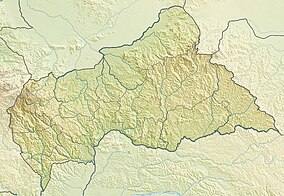Bamingui-Bangoran National Park and Biosphere Reserve
| Bamingui-Bangoran National Park | |
|---|---|
 | |
| Location | Central African Republic |
| Coordinates | 8°11′N 20°14′E / 8.183°N 20.233°ECoordinates: 8°11′N 20°14′E / 8.183°N 20.233°E[1] |
| Area | 11,191 km2 (4,321 sq mi) |
| Established | 1933 |
The Bamingui-Bangoran National Park complex is a national park and biosphere reserve located in the northern region of the Central African Republic. It makes up part of the Guinea-Congo Forest biome.[2] It was established in 1993.[3] The Vassako Bolo Strict Nature Reserve is in the midst of the park.[4]
Geography[]
The park and biosphere reserve complex is located in the country's centre-north, west of N'Délé and close to the border with Chad.[2] Reachable from Bangui, the capital city, it is situated to the west of Manovo-Gounda St. Floris National Park,[5] and holds a higher density and a larger number of wild animals than Manovo-Gounda.[4]
The national park is 1,070,000 ha in size, and lies within the mid-Sudanian phytogeographic domain of the Central African Republic.[6] The park is situated on a plateau at an elevation of 400 metres (1,300 ft) to 500 metres (1,600 ft) above sea level. Its waterways drain north-westwards to the Chari River.[7] The left bank floodplain of the is protected for 202 kilometres (126 mi) as are 105 kilometres (65 mi) of floodplain on the . A relatively small section, approximately 30 kilometres (19 mi) section on the Bangoran's right bank, is excluded from protection.[8]
The climate includes a rainy season of May–October in the southern reaches while diminishing to June–September in the northern areas. It can be muggy all year.[5]
Flora and fauna[]
Bamingui-Bangoran's major ecosystem is characterized as tropical dry or deciduous forests while the major habitats and land covers are dry forests, wooded savannas, edaphic savannas, and gallery forests.[9] Trees include the Terminalia, Isoberlinia doka and Anogeissus.[10]

The sub-specific endemism seen in the large mammals appears to link to Chari-Logone River system Pleistocene isolation.[6] One mammal is considered endangered, the Chadian wild dog, while the Sudan cheetah, Central African lion, and African manatee are classified as vulnerable. According to Spinage, antelope populations have declined markedly since 1960 within the park.[10]
The park reserve's amphibians include the Mascarene ridged frog, sharp-nosed ridged frog, Schilluk ridged frog, Galam white-lipped frog, cryptic sand frog, ornate frog, crowned bullfrog, flat-backed toad, shovelnose frog, Senegal kassina, and Natal puddle frog.[1] The red faced lovebird is found here and in Nigeria's Gashaka Gumti National Park.[11]
Threats[]
Ecological threats to the park reserve include foreign timber and mining concessions, poaching, and agriculture land-clearance.[5]
References[]
- ^ Jump up to: a b "Overview of Bamingui-Bangoran". bioval.jrc.ec.europa.eu. APAAT. Oct 28, 2010. Archived from the original on 23 March 2012. Retrieved 23 April 2011.
- ^ Jump up to: a b "Central African Republic (CAR) Important Bird Areas". africanbirdclub.org. Archived from the original on 28 July 2011. Retrieved 23 April 2011.
- ^ "Bamingui Bangoran National Park". protectedplanet.net. Retrieved 23 April 2011.
- ^ Jump up to: a b Bouché, P.; Renaud, P.-C.; Lejeune, P.; Vermeulen, C.; Froment, J.-M.; Bangara, A.; Fiongai, O.; Abdoulaye, A.; Abakar, R. & Fay, M. (2010). "Has the final countdown to wildlife extinction in Northern Central African Republic begun?". African Journal of Ecology. 48 (4): 994–1003. doi:10.1111/j.1365-2028.2009.01202.x. Retrieved 23 April 2011.
- ^ Jump up to: a b c "Bamingui-Bangoran National Park and Biosphere Reserve". naturesstrongholds.com. Archived from the original on 23 March 2012. Retrieved 23 April 2011.
- ^ Jump up to: a b Spinage, C. A. (1988). "First steps in the ecology of the Bamingui-Bangoran National Park, Central African Republic". African Journal of Ecology. 26 (2): 73–88. doi:10.1111/j.1365-2028.1988.tb00959.x.
- ^ "CF003 Bamingui-Bangoran National Park complex". Birdlife. Retrieved 23 April 2011.
- ^ Hughes, R. H.; Hughes, J. S. (1992). A directory of African wetlands. IUCN. pp. 486–. ISBN 978-2-88032-949-5. Retrieved 23 April 2011.
- ^ "Biosphere Reserve Information Central African Republic BAMINGUI-BANGORAN". UNESCO. 2000-02-14. Retrieved 23 April 2011.
- ^ Jump up to: a b East, Rod (1 January 1990). Antelopes: Part 3 – West and Central Africa: Global Survey And Regional Action Plans. IUCN. pp. 102, 104–. ISBN 978-2-8317-0016-8. Retrieved 23 April 2011.
- ^ Forshaw, Joseph M.; Knight, Frank (27 September 2010). Parrots of the World. Princeton University Press. pp. 154–. ISBN 978-0-691-14285-2. Retrieved 23 April 2011.
- IUCN Category II
- National parks of the Central African Republic
- Protected areas established in 1993
- Bamingui-Bangoran
